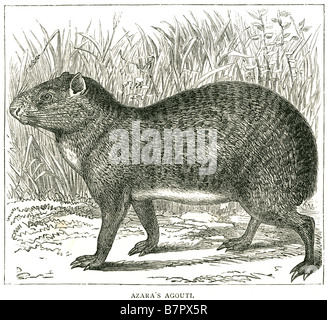
The floor pens population consisted of both sexes, and the female to male ratio was 5 : 1. At that location, there were over one hundred agoutis at all physiological states being reared. Housing of Agoutis at University Field Station (UFS)Īt the location where the observations on the agoutis were made, animals were housed in cages and on floor pens. Trinidad and Tobago is located in the humid tropics with an average temperature of 32☌ to 22☌, rainfall of 1000 mm, and humidity of 82%. The University of the West Indies (UWI) Field Station is located at Mt. Thus, the omnivorous behaviour of these animals which were historically given little attention is highlighted. The manuscript attempts to report a situation where captive reared agoutis consumed chicken ( Gallus domesticus) eggs, a dead chicken, and a brown dove ( Zenaida macroura). In the literature, the agoutis have been classified as frugivores, herbivores, or opportunistic feeders with little attention given on this animal’s omnivorous behaviour. If diets are to be formulated to feed these animals in captivity, then reference blood values will be essential in identifying the effect that diets will have on the agouti’s performance. However, there were differences in serum biochemical values among sexes. Recent works on blood parameters of agoutis have been reported, and there was no difference seen in blood reference values between male and female animals.


A parasite is defined as an organism which is present in the host and affects the host clinically or subclinically. In captive reared animals, parasitic organisms have also been identified, but no effects on the animals were reported either clinically or subclinically. These Neotropical animals had parasitic organisms present, but authors failed to report the effect but chose to only view these animals as reservoirs for diseases. Further work reviewed endoparasites of domesticated animals that originated from the Neotropics. Gastrointestinal parasitic organisms were found in wild agoutis in Trinidad, but no effect on the animals’ health or performance was observed. Pathogen harboured by the agouti was reviewed but no apparent clinical effects on the animals were noted. In South America, analysis of blood hormones (oestrogen and progesterone) and the oestrus cycle was investigated in the agouti, and the duration of the cycle was approximately 28 days. Gross anatomy of the male and female reproductive systems in the agouti was investigated in Trinidad electroejaculation was performed in the male animal. The preferred feed particle size in feeding agoutis was found to be 12.7 mm × 25.4 mm for captive reared animals. These animals also had a large caecum which facilitates hindgut fermentation. Recently, a study on the anatomy of the digestive system has been done, and it was identified that the small intestines of the agouti were larger in comparison to the rabbit. There is a dearth information on the biology of the agouti, but recently in the Caribbean and South America, some research work has been conducted. Other authors categorized the agouti as frugivores and herbivores. The authors have stated that the agouti diet consisted of mainly fruits and seed. The agouti has been reared in captivity and has potential for domestication.

It was one of the several species described as mini livestock which can be utilized by rural communities as an essential source of meat protein. These animals have been hunted for their meat in rural areas. The agouti is a Neotropical rodent has been reported to inhabit South America, Central America, Mexico, and the Caribbean Antilles. Further work must be done on the dietary needs and nutrient requirements of the agouti at different physiological states. Similar studies in South America have shown that wild and captive reared agoutis consumed animal matter. This document described the omnivorous behaviour of the agouti which is primarily considered a frugivorous animal. The consumption of chicken ( Gallus domesticus) eggs, dead chickens, and a brown dove ( Zenaida macroura) by captive reared agoutis was noted. This is the first time in Trinidad and Tobago that meat consumption and the omnivorous behaviour of the agouti have been documented in the literature. This short communication consists of observation of feeding behaviour of captive reared agoutis at the University of the West Indies Field Station in Trinidad and Tobago. Recently, captive rearing of these animals by wildlife farmers have increased in the Neotropics. The agouti is a Neotropical rodent which is mainly utilized for its meat in rural communities.


 0 kommentar(er)
0 kommentar(er)
